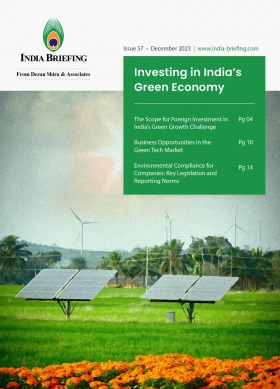India-ASEAN Trade Pact: Tariff Anomalies on Goods to be Reviewed
India has begun reviewing its trade agreement with the ASEAN bloc to reassess products where taxes on input items are greater than the finished goods.
India is preparing for a comprehensive review with the 10-member ASEAN (Association of Southeast Asian Nations) grouping to identify and correct several anomalies that have undermined its domestic manufacturing sector. According to media reports, India wants to examine alleged discrepancies in import duties, rules of origin, and non-tariff barriers.
Meanwhile, India’s Ministry of Commerce and Industry has reached out to relevant industry stakeholders to submit their feedback on products that are in a disadvantageous position due to the inverted duty structure.
An inverted duty structure on certain items, like ferro alloys, aluminum, copper pipes and tubes, textile staple fibers, and several chemical preparations, puts the Indian industry at a disadvantage. As a result, it’s important to evaluate inverted duty systems in free trade agreements (FTA) particularly if the FTA accounts for a large portion of all imports.
Review of the ASEAN-India Trade in Goods Agreement
The review of the ASEAN-India Trade in Goods Agreement (AITIGA) is expected to facilitate the expansion of trade between India and ASEAN in a ‘balanced and sustainable manner’.
The AITIGA was signed in 2009. In September 2022, both sides tasked the AITIGA Joint Committee to undertake the review with the aim of making the agreement more trade enabling and mutually beneficial.
Subsequently, a total of eight sub-committees have been constituted to undertake negotiations on different policy areas related to the AITIGA agreement.
In 2023, India and the ASEAN countries agreed to review their free trade pact for goods and address the “asymmetry” in bilateral trade by 2025.
India-ASEAN trade reportedly grew to US$131.58 billion in 2022–23.
Deepening trade ties with ASEAN
India is seeking to strengthen its trade relations with ASEAN countries. Amid the ongoing pact review, it has reportedly agreed on the modalities of the overall review process of the pact. One of the concerns for India is that non-ASEAN countries are re-routing exports through ASEAN countries to avoid taxation burdens.
Timeline
- ASEAN-India Trade in Goods Agreement (AITIGA) came into force on January 1, 2010
- India-ASEAN Trade in Goods Agreement, signed on August 13, 2009
- India-ASEAN Agreement on Trade in Services, ratified July 1, 2015.
- India-ASEAN Agreement on Investment, ratified on July 1, 2015
- India-Thailand FTA, signed on October 9, 2003 – Early Harvest Scheme (EHS) implemented on 1.09.2004.
- India-Singapore Comprehensive Economic Cooperation Agreement (CECA) signed on June 29, 2005, and implemented on August 1, 2005.
- India-Malaysia Comprehensive Economic Cooperation Agreement (CECA) signed on February 18, 2011, and implemented on July 1, 2011.
- India became ASEAN Dialogue Partner in 1996.
Under their trade arrangement, the two parties had decided to remove levies on around 75 percent of commodities and lower tariffs on approximately 15 percent of goods.
However, the 10 ASEAN nations committed to varying rates of tariff removal. While Vietnam promised a lower share of tariff negotiation, Singapore stated it would deliver 100 percent tariff elimination; as a result, the agreement has a diverse duty structure.
Vietnam’s tariff reduction commitments under AIFTA
The ASEAN–India Free Trade Area (AIFTA) was endorsed by Vietnam’s Prime Minister in 2009, and became effective on June 1, 2010. It mandates scheduled reductions in import taxes, starting in 2010 and concluding in 2024.
Understanding ASEAN ties with India
ASEAN member countries are Brunei Darussalam, Cambodia, Indonesia, Lao PDR, Malaysia, Myanmar, the Philippines, Singapore, Thailand, and Vietnam. For India, its Foreign Trade (ASEAN) Division deals with the following issues related to these countries:
- Foreign Trade
- Trade Promotion
- Trade Negotiation and Review
India – ASEAN trade figures
|
India’s trade with ASEAN countries |
2016-17 |
2017-18 |
2018-19 |
2019-20 |
2020-21 |
2021-22 |
2022-23 |
|
Export (US$ billion) |
30.96 |
34.20 |
37.47 |
31.55 |
31.49 |
42.32 |
44.00 |
|
% growth |
23.19 |
10.47 |
9.56 |
-15.82 |
-0.19 |
34.43 |
3.95 |
|
Import (US$ billion) |
40.62 |
47.13 |
59.32 |
55.37 |
47.42 |
68.08 |
87.57 |
|
% growth |
1.77 |
16.04 |
25.86 |
-6.66 |
-14.36 |
43.57 |
28.64 |
|
Total (US$ billion) |
71.58 |
81.34 |
96.80 |
86.92 |
78.90 |
110.4 |
131.57 |
|
Trade balance (US$ billion) |
-9.66 |
-12.93 |
-21.85 |
-23.82 |
-15.93 |
-25.76 |
–43.57 |
Data Source: Department of Commerce, Ministry of Commerce and Industry
Outlook
As per trade experts in India, it may be feasible to correct these differences under AITIGA within the annual budgetary processes for imports under the Most Favoured Nation (MFN) principle.
However, correcting such tariff imbalances may prove to be more difficult to navigate with the respective foreign trade agreements with each country. For now, while the final product may be imported duty-free under an FTA, necessary raw materials may need to be procured from non-FTA nations at higher MFN duties.
About Us
India Briefing is one of five regional publications under the Asia Briefing brand. It is supported by Dezan Shira & Associates, a pan-Asia, multi-disciplinary professional services firm that assists foreign investors throughout Asia, including through offices in Delhi, Mumbai, and Bengaluru in India. Readers may write to india@dezshira.com for support on doing business in India. For a complimentary subscription to India Briefing’s content products, please click here.
Dezan Shira & Associates also maintains offices or has alliance partners assisting foreign investors in China, Hong Kong SAR, Dubai (UAE), Indonesia, Singapore, Vietnam, Philippines, Malaysia, Thailand, Bangladesh, Italy, Germany, the United States, and Australia.
- Previous Article Environmental Compliance for Companies in India: Key Legislation and ESG Guidelines
- Next Article India-Peru Trade Agreement: Bilateral Negotiations Ongoing








